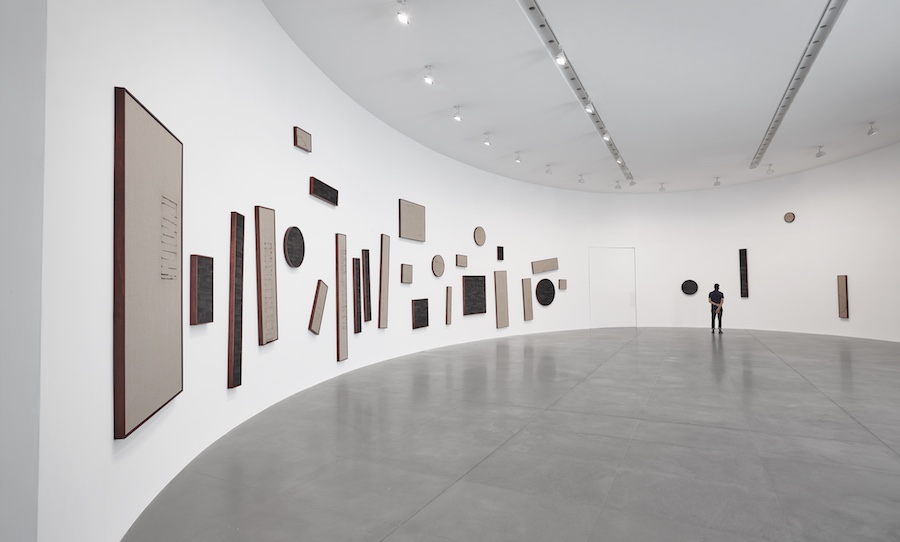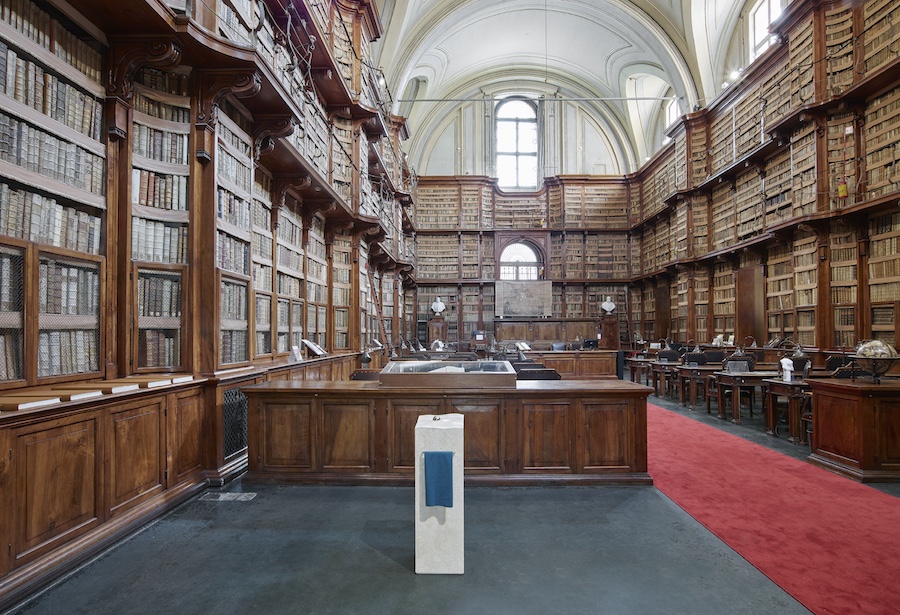
English text below
Gagosian presents Iron Levels, new works by Davide Balula (Rome, September 21–November 18, 2017).
At once surreal, comical, and critically engaged, Balula’s works examine the intersection of philosophy, phenomenology, and physics. For the Rome gallery, he has created an experiential trajectory that responds directly and specifically to the architecture. On entering the exhibition, visitors pass through a sculptural metal detector. A ubiquitous instrument of search and verification, the metal detector makes private belongings into objects of suspicion or potential threat. Its purpose is to reveal the metal, non-bodily material we carry with us each day—keys, coins, cell phone—that which we habitually treat as extensions of the self. The metal detector functions as a portal, further separating the idealized space of the gallery from the world outside.
Interview with the artist —
ATP: What do you find fascinating about the technologic world? Do you reckon it could be like some impenetrable and unknown dimension?
Davide Balula: I don’t see technology as a different world so i would characterize it more as highly penetrable. To the point that genetic alterations might even take over and influence consciousness.
ATP: How does your project for the Gagosian Gallery venue in Rome was born? What was the idea inspiring the develop of your project?
DB: The space in Rome is unique, and I have a special relationship with curved walls I must say. After my first visit I kept thinking about how the air and acoustics circulate in such a space, the echo you hear and the time it took to bounce back, how sound travel is really just a super small wind, and how a slightly more consequent drift could lift light particles people leave in the space, skin flakes, dust. I kept thinking about weight and air pressure and things followed, gravity or the lack of it. Decisions to choose a project over an other for a specific space is always tricky for me, so most of the time i think about specificities and start from there.

ATP: You decided to install a metal detector at the gallery entrance. It’s like an access door dividing two worlds. I think it’s a door that makes us aware of all the elements and foreign matter on us. Can you tell me what does the metal detector means to you?
DB: It is related to the title of the show Iron Levels. Iron Levels is a reference to the fact that metals have been forged to create the simplest tools, but are also what produce the bright hue of my blood. Iron can be found at any level of the earth’s crust as much as in plants and animals’ cells, allowing the most basic activities and exchanges at a cellular level. In a way related to your first question. How remote is technology from my own body. How much of a technological act is a simple pressure of the finger on a static object. How much metal can we carry, how foreign are different materials we live with everyday, phone, jewelry, clothes, tooth fillings, keys… How fast do you forget about the shape of a broken tooth, the weight of sunglasses on your nose, the pressure of a ring on your finger, its temperature or its smoothness on neighboring fingers. The “world” you enter is a world of temporary awareness. And it fades fairly fast, everyone knows how used to our own body weight we get until a pain or injury reminds us of its exactitude.
ATP: I’m really fascinated by the steel globe artwork. You collaborated with some local artisans for its container made with calcareous stone. How did you relate with these artisans? Are you interested in working with some experts processing some particular materials?
DB: It is true that I often try to fabricate works close to the place they are first shown. It is a great excuse to explore new technics and materials. And you always end up finding passionate people who like to excel in what they do. Those discussions are always very stimulating. The receptacle for that piece is made of Travertine carved out near here. I like the idea of displacing terrains and thinking about a portable piece of land. When your mind can carry it afterwards.
ATP: Is there a relation in between the spherical artwork and the series of the well known Burnt Paintings you present in the oval room of the gallery?
DB: Yes they were thought to balance each other in the show. Both relate to different levels of gravity.
ATP: Speaking of the Burnt Paintings, it’s been some years now that you develop this series. How did it evolved through time?
DB: That series in particular continues to rely on the relationship the divided parts maintain with the whole. So it is as much the content trapped inside the frame as the content that separates them. One is contained and stable in apparence, one is more noticeably evolving as people walk or breathe through it. Working on series for many years allows you to continue this discussion you can have late at night with a close friend. Although you know of his/her characteristics pretty well, and more and more as years go by, the tone of his/her voice, how he/she could stand in the discussion, etc, you somehow continue to be surprised and stimulated by his/her insights every new exchange, and when the night is over, you ask for more hangout time. It becomes natural to keep developing such a relationship further.
ATP: In the series that you will present in Rome, there’s some meaningful specularity: on one side the process, on the other its outcome. Can you briefly tell us what did you develop in these artworks?
DB: As I am writing this, the show is almost installed. But i would encourage you to come see it in person since its outcome, and more importantly its process depends on your presence really. 🙂


Unique BALUL 2017.0019
Davide Balula — Iron Levels, Gagosian, Roma
Sono affascinato dalla strumentazione e dalla tecnologia in generale…Credo nell’idea di un corpo “prolungato”. Sappiamo così poco, percepiamo così tanto.
—Davide Balula
Gagosian presenta Iron Levels, una mostra di nuove opere dell’artista francese Davide Balula. Surreale, spiritoso e impegnato, il lavoro di Balula esamina l’interrelazione tra filosofia, fenomenologia e fisica.
Per la galleria di Roma, l’artista ha creato un percorso esperienzale direttamente collegato all’architettura dello spazio. All’ingresso, i visitatori sono invitati ad attraversare un metal detector, strumento di indagine e controllo ormai onnipresente che tramuta gli oggetti personali in materiale sospetto e potenzialmente minaccioso. Il suo fine è rivelare il metallo e il materiale non-corporeo che portiamo con noi ogni giorno—chiavi, monete, cellulare—e che consideriamo abitualmente come un’estensione di noi stessi, fungendo quindi da portale che separa lo spazio idealizzato della galleria dal mondo esterno.
Nella prima sala il visitatore è invitato a prendere in mano una sfera di acciaio. Il suo contenitore, scolpito da artigiani locali in pietra calcarea, rievoca la morbidezza e le curve della pelle e la resa anatomica dei Maestri scultori italiani. La sfera e il suo supporto esplorano l’equilibrio gravitazionale tra il corpo e la Terra, invitando a riflettere sul peso, la massa e la densità. In Air Between Fingers (2014), un video di 1:47 minuti girato con un iPhone, il pollice e il dito medio di Balula si sfiorano lasciando un millimetro di spazio tra i polpastrelli, toccandosi occasionalmente come se l’artista perdesse il controllo su uno spazio così ridotto, in un’affascinante rappresentazione di forza di gravità, attrito e magnetismo che agiscono sul corpo e al suo interno.
La sala ovale ospita una nuova serie dei noti Burnt Paintings di Balula, realizzati appositamente per l’ampia curva della parete principale. Queste opere presentano due elementi binari: uno contiene il residuo di carbone che resta dal legno bruciato, e l’altro l’impronta su tela lasciata dallo stesso carbone. In gruppi di due, tre o quattro elementi per opera, questi “dipinti” vivono in una stretta relazione di positivo e negativo, come nella fotografia o nel processo di stampa. Il processo di creazione del carbone è lento e continuo con un graduale aumento e diminuzione della temperatura, in modo che il legno non diventi cenere ma possa essere bruciato ancora. I Burnt Paintings esaminano la ciclica, quasi alchemica, trasformazione di energia in natura, fenomeno fondamentale nel lavoro di Balula.












